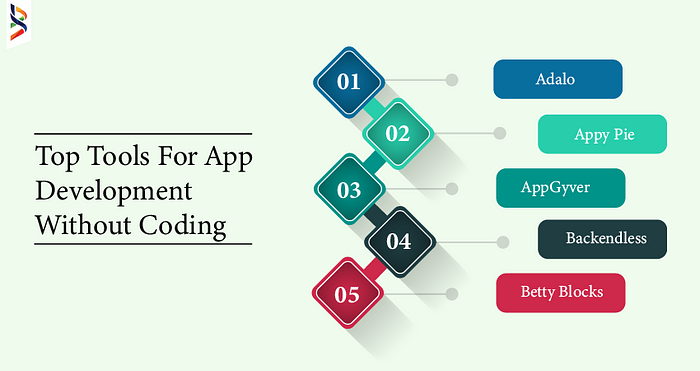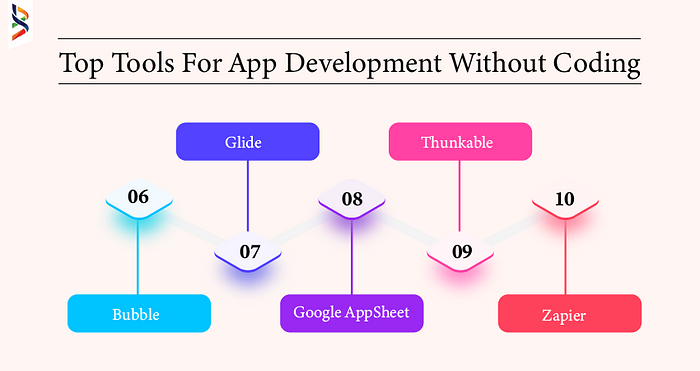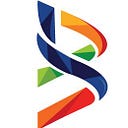10 Tools to Build Your Own Mobile App Without Coding

What is a No-code Mobile App Development Service or Platform?
In simple terms, it is a “no-code” application platform or development service a software development tool that allows developers at a beginner level to develop a web or Mobile App Without Coding by dragging and dropping various elements.
The process is considerably less laborious and simple since you don’t have to write code.
Since no programming is necessary, it makes the process of creating a Mobile App Without Coding much easier and allows users with little or no expertise in programming to construct an app that is basic.
Additionally, this kind of tool help makes it easier for app developers to conduct tests.
The basic idea is that these platforms or services allow you to select and mix modular components, each being a particular step or task. In essence, this is the essence of it.
We’ve read the reviews, and looked at blog posts to bring you the A from Z checklist (quite practically) of the 10 top tools for developing apps that do not require any programming.
So, if you’re looking for an individual web or mobile app and you have the desire to develop the app yourself, but do not have the expertise or skills these are the top platforms and services you can look into.
Top Tools for the development of Mobile App Without Coding

1. Adalo
Adalo allows users to transform their side hustles and startup concepts into reality with no programming.
It doesn’t matter if you want to let users browse your content, such as projects, or provide them with the ability to purchase products or services using it, you are able to use Adalo to develop an app for your content or a paid product.
If you’d like to get on board and develop your own Facebook or Twitter apps using Adalo, you can do that with Adalo to create it.
You can design your user interface (UI) for your application by dropping and dragging modular building elements (there are over 25 gorgeous elements) and then connect to the different pages within your app by using, for instance, the ability to create a custom animation.
Additionally, it comes with Stripe integration for those who want to incorporate payments directly into your app.
Other features it allows you to add are the ability to trigger push notifications that are targeted to users as well as the ability to open the user’s photo library and camera.
2. Appy Pie
Not to be mistaken for PewDiePie which is one of the most popular (and more controversial) creators of content, Appy Pie is a free platform for creating apps.
The popularity of the platform is equally impressive and is used by over 10 million users, which makes it one of the most popular app creators currently on the market.
Appy Pie’s aim is to make high-tech accessible to those with fewer technology capabilities. In simpler terms, their aim is to even the playing field.
This means that whether you’re a freelancer, student, or business owner, your services can be tailored to suit diverse requirements and budgets.
3. AppGyver
As per the LinkedIn site, AppGyver was the world’s first professional, no-code, professional platform to build applications for mobile devices as well as for desktops as well as TV, browser, and.
With over 300,000 users AppGyver provides user-friendly and business-oriented tools that can assist you in creating apps fast.
The program’s Composer Pro offers countless style features and easy drag-and-drop control. You can create virtually anything that you’d like to by mixing hundreds of logic functions.
If you can’t locate the element you’re seeking among its 500+ elements it is possible to make your own component which you then offer to the rest of the community.
4. Backendless
In 2012, Backendless was released. Backendless was launched in 2012 as a full-stack visual application development platform that doesn’t require code.
It was designed to simplify the development of mobile apps by assisting users, which include major brands like Columbia, Kellogg’s, and Dell to cut down on a lot of time and stress.
The platform comes with a visual user interface builder that is code-free. With its drag-and-drop features making the front end of your application (or website) is an easy task.
Furthermore, you can utilize it to build apps for mobile, web, or both.
However, if you find yourself stuck, it provides numerous video tutorials that will guide users through each step and assist you to navigate the builder and its functions.
They also have a library of guides to how-to (or as they prefer to call them, recipes). In addition, you’ll get more information about the impressive features of the platform.
5. Betty Blocks
In 2016, the company was founded. Betty Blocks is a citizen development platform that makes it simple to use, quick, and enjoyable to create complex, enterprise-quality applications.
Their aim is to ensure that everyone can build apps with each other by 2023.
For instance, they assisted Zorg van der Zaal, a healthcare provider for corporate clients and wellness and lifestyle experts to develop a brand new application that they could use to invite employees, record tests, and distribute personal questionnaires.
The final result was cutting scheduling time in half.
No matter if you’re a developer for the citizen or a business organization You’ll be able to utilize it.
In order to build an application using its visually appealing interface with drag-and-drop along with pre-programmed construction blocks.
Although its UI builder is flexible and extremely intuitive, it doesn’t come without its limitations and you can utilize it to build complex apps.
If you’re experienced with JavaScript it can also support JavaScript along with HTML integrations for further personalization.
Therefore, in contrast to a tool such as AppSheets that is intended for the creation of simple applications Betty Blocks allows you to build advanced apps as well.
Furthermore, they provide an excellent level of assistance if you be stuck. They will provide you with a personal connection with their staff and they’ll provide you with instruction too.

6. Bubble
If you’re specifically looking to create web-based apps instead of mobile apps then you should check out Bubble.
Popular with millions of users, it’s one of the most well-known non-code platforms that can be used to build robust apps for desktop and mobile browsers without writing every line of code.
With its drag-and-drop editor you can design multi-user, interactive apps with real-time interaction, such as chat, news feeds, and maps.
Then ensure that your app appears perfectly on mobile devices with mobile-friendly layouts, it comes with mobile-friendly designs as well as an intuitive editor.
It can also be used to set up user accounts as well as support logins that require passwords, which makes it an excellent tool to have for managing information and accounts.
In addition, if user-generated material (UGC) is a major element in your strategy for digital marketing, then you could also display UGC.
If you’re catering to a wide, international population, why not develop an app that is multi-lingual? With Bubble it’s easy.
Bubble currently supports over 80 languages across the globe, which means the app can convert any language you use within your app and automatically display it in the correct language (or currency, for that matter).
To monitor how your new application is performing it provides valuable analytics which you can analyze using its impressive dashboard.
7. Glide
A quarter of a million companies and users have chosen Glide to develop apps and their platform that doesn’t require code is used to build thousands of applications already.
Since it’s a zero-code platform, you do not need to write one line of code to build an impressive app, making it an ideal option for those who are new to programming.
Through its simple modular blocks, It is possible to transform the data you have stored into an application that is stunning on iOS as well as Android devices even tablets.
Furthermore, your data is synced in real-time, so you’ll be able to rest assured the app you download will remain current.
If you’d like to make your application available to more than those in your organization, Glide also gives you the option of making your app open to everyone so that people from all over the world can access it.
In order to tailor the user experience It allows you to save data to the user’s profile.
However, in contrast to other apps that could assist you in publishing your application such platforms as Google Play or the App Store, applications created using Glide are distributed as an uncomplicated web URL instead.
It means that users do not require to download and install your app initially.
8. Google AppSheet
While Google and its other products like Google Docs require no introduction, you may not be aware that it provides a code-free app solution. In actual fact, it’s been utilized to develop more than 4 million apps in the past.
From tools for managing projects to sales tools, they can be utilized to solve a variety of problems. Additionally, it is compatible with both desktop and mobile devices.
Since it’s a no-code system, anyone (even users with no prior programming expertise) can utilize it to develop apps and automate the process.
Its AppSheet Editor lets you generate app prototypes in a matter of minutes and offers ideas for how to alter them quickly.
To test the app, all you have to do is make a connection with AppSheet to your cloud-based storage services, such as Google Drive or Salesforce.
Open your spreadsheet, or the database you’d like to use in your app, define the way in which data is utilized, then create an overview, and then customize the appearance and experience of your app by choosing colors designs, and themes.
Once you’ve created your app, you’ll be able to invite users to try your application. The next thing to do is to launch the app and it’ll be ready and live.
9. Thunkable
Thunkable is utilized by millions of developers to convert their ideas into apps that are compatible with Android, iOS, and the web.
In the past, over seven million applications have been developed thanks to Thunkable’s all-in-one, a zero-code platform for app development.
In the end, it’s an excellent option if you’re looking to bring your business or product to the mobile market and adopt the mobile-first strategy.
It provides a basic and yet quite powerful drag-and-drop design tool, with more than fifty design elements simple animations, and endless logic blocks.
Making your app available for download is also easy because of its direct application capabilities to App Store, Google Play and Apple’s App Store Google Play, and the internet.
Furthermore, they’ll handle the app marketplace’s compliance requirements so you don’t have to think about this difficult aspect.
10. Zapier
There’s a good chance that you’ve been exposed to or heard of Zapier before.
If you’ve looked around for solutions that use software such as Social Media Management platforms and integration with Zapier is among the most popular features you’ll come across.
It is connected to over 4000 of the most well-known apps, which is the largest number of connections available on the platform.
It was launched in 2011 and is backed by well-known global brands such as Slack, Asana, and Meta Zapier is a cloud-based integration software that allows you to integrate applications, like Dropbox and Salesforce in order that data can be transferred in a seamless manner.
If you are using several apps, you can make use of Zapier to connect the two platforms and create an app yourself with their no-code click-and-click Zap Editor.
Wrapping Things Up
The hiring of professional developers to create an application that’s custom isn’t something everyone can afford, especially not for those who are creators or small-scale businesses.
But, depending on the niche you’re in and your business, having your own Mobile App is something that you shouldn’t be able to afford.
The app market has grown exponentially and, based on statistics from the internet on mobile apps’ usage the Mobile App that are branded can get more interactions than social media posts that are sponsored.
Furthermore, more than 20% of users have reported that they find new brands, products, and services through mobile apps.
There are many good no-code development tools designed for users who have little (or limited) experience with programming languages.
Furthermore, since the majority of them offer drag-and-drop functionality that even non-technical users can be able to comprehend the concept.
https://www.brisklogic.co/10-tools-to-build-your-mobile-app-without-coding/?feed_id=1172&_unique_id=63b861a4b6c1c
